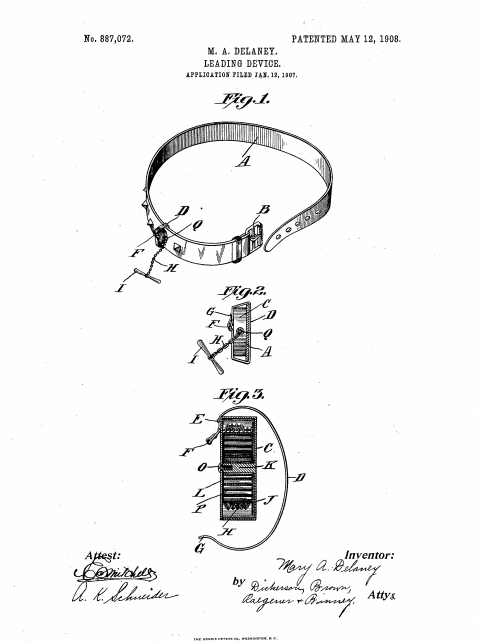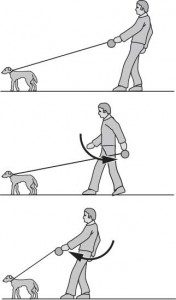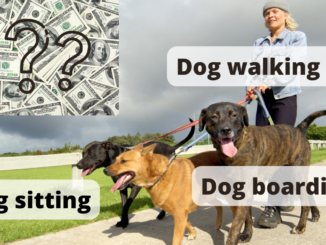
Retractable leashes cause over 16,000 injuries every year … or do they? Learn the truth about the pros and cons of this controversial tool.
Every year, over 30,000 people are injured by table saws. Many of these injuries are severe enough to require emergency room treatment, and over 4,000 result in amputation of fingers. Despite these alarming figures, no one calls for a ban on table saws. Why then are so many clamoring for a ban on retractable dog leashes? Are they really dangerous?
A number of anti-retractable leash articles claim yearly injuries related to their use exceeding 16,000, but despite extensive research I was unable to find any citation for this claim. A query of the Consumer Products Safety Commission’s National Electronic Injury Surveillance System shows a total of over 80,000 hospitalizations in 2018 resulting from “pet products.” The Journal of the American Medical Association reports an increase in dog walking related fractures in seniors 65+, with over 4,000 cases reported in 2017. What these figures tell us is that dog walking can be hazardous in any case, and that retractable leashes are no more dangerous than any other.

If they aren’t dangerous then why all the fuss? Bring up retractable leashes in any conversation with dog folk and there’s sure to be a heated discussion. Like many controversial subjects, there are different sides to the story and no one easy answer. Safe or unsafe use of the retractable leash boils down to quality and maintenance of the product, location used, behavior and training of the dog, and most importantly, user ability and knowledge.
History of the retractable leash
The first time I saw a retractable leash was in 1994. I had just started my pet sitting career working for a service in San Francisco, and that day I was meeting a new client with a charming black Standard Poodle called Izzy. After going over all the care details with the owner, she produced a strange looking device, held it up, and said, “Do you know how to use this?” I tried to bluff but the look on my face gave me away. She smiled and showed me how the cord of the leash extended, and how the button acted as the brake. “Okay,” I thought, “We’ll see how this goes.”
When I arrived for my first visit, I puzzled over the leash for a minute then attached it to Izzy’s walking collar, which I believe was a choke chain. Off we went up and down the hills, and I was instantly hooked. Izzy was a good walker, as are many city dogs, and all went smoothly. I loved the ability to allow freedom of movement and especially the way the leash stayed up off the ground, never dropping down and getting tangled under the dog’s legs as so often happens while walking.
As it turns out, I wasn’t the only one to appreciate this improvement. The 90’s was a great time for dog innovations, with new products like the head collar and front-attaching harness coming on the market, but the origins of these “new” products go much further back. The first known patent for the retractable leash was filed in Manhattan, New York, in 1908 by Mary Delaney, who stated, “It is usually desirable that the dog should have a certain freedom in running about, but it is difficult to prevent the animal from running on the wrong side of lamp posts or pedestrians, thus causing much annoyance to the owner, who is constantly required to adjust the length of the leash in her hand, and frequently the leash is dropped and the dog permitted to run away. The objects of the present invention are to obviate and overcome all these difficulties and annoyances due to the usual form of leash, and prevent the leash from becoming tangled as the dog runs about.”

Quality counts
German Manfred Bogdahn of Flexi claims to have invented the retractable leash in its present form in 1972, although this newspaper ad from 1941 depicts otherwise. The text of the ad reads, “Smart dog owners carry leashes wound on spring reels. The leashes encased in Tenite are styled in lustrous colors to match almost any costume. By simply pressing a small switch on the handle, the dog may be controlled at any desired distance. Tenite will withstand rough handling without denting or chipping.”

Today’s retractable leashes come in many sizes, colors, and levels of quality. I’ll come right out and say if you’re going to use this kind of leash, I only recommend the Flexi brand. They are the best quality and will last for years with proper care. There are many cheap knock-offs that easily break: the cord may pop right out of the casing, the brake may not work, or the whole thing may burst apart in your hand (ask me how I know)! I personally prefer the tape over the cord, and the shorter length over the longer. 16 feet/5 meters is plenty of room for your dog to walk without getting into too much trouble. The “classic” style has a nice small handle that is easy for anyone to hold. With my piano fingers I didn’t have a problem with the older, larger, heavier models, but they were an issue for dog walkers with more petite hands.
Care and maintenance
The leash consists of a cloth cord or tape and a metal spring mechanism inside a plastic casing. If the cord/tape gets wet, you must dry it out before re-storing it in the casing! If you don’t, not only will the cord/tape smell bad, the metal parts will rust and deteriorate. After a wet walk, pull the leash all the way out and lock the brake. Preferably hang it over a towel rail or some such so it can easily dry – don’t leave it in a pile. Hang the leash up when not in use. Don’t leave it on the floor, and try not to drop it. The high-quality Flexi is tough but not impervious.
City leash, country leash
As I mentioned, my first experience with a retractable leash was in the city, and it was a positive one. However, in the ensuing months and years I learned the potential downsides of using such equipment in close confines. Jack and Jill were Jack Russell Terriers purchased during the breed’s heyday of popularity. They lived in an apartment so had to be walked every time they needed to go potty. Their owner had the aforementioned cheap knockoff retractable leashes, and I soon discovered their issues. As I walked down a busy street past a bunch of shops, nervous Jill suddenly had a bout of spraying diarrhea right in front of a vegetable stand! The angry store owner ran out yelling and waving his arms, startling Jill who suddenly bolted to the end of the leash … which snapped right out of the casing. Away she went through a crowd of annoyed shoppers with me running after her. Thank goodness we were pretty bonded at that point so she came back and I was able to carry her home.
That experience opened my eyes to the potential problems walking in more crowded areas with little room for error. For that reason, I do not recommend using them at the veterinary hospital, grooming salon, or other crowded place. There’s no reason to let your dog roam when you’re distracted and have your hands full. When I moved to the South Bay I walked my three dogs, all on retractables, in a nearby park on the trails. I rarely saw other people and had plenty of space, so there were no issues … well, except when a squirrel would suddenly dart into view. This leads to the next consideration, the behavior and training of the dog.

Dog behavior and training
As mentioned earlier, there are thousands of injuries every year related to “pet products,” and we can assume that many of those involve dog walking. Slips, trips, and falls are the bane of anyone working outside, especially while carrying things like mail or parcels, or while walking dogs. An unruly dog on any kind of leash is a hazard to all involved. Larger and more active dogs like Labs and Huskies have the potential to pull the walker off their feet, especially if they see something that interests them. However, small dogs can do the same under the right circumstances. Dogs are unpredictable and will react to their surroundings which are also unpredictable. Dogs who don’t get out very often, who are skittish or fearful, or who don’t get enough exercise can be problematic. Knowing your dog or the dog you’re walking is critical to having a safe and pleasurable experience.
A little training goes a long way, as does time spent together. One of the best behaved dogs I ever knew was a Weimaraner with separation anxiety, Bella. Because she was with people all the time and always on a leash away from home, she was so quiet you hardly noticed her. In fact, I once took Bella to a Board meeting at my local play house and she just lay down under the table the whole time. While a basic training class will benefit any dog, it doesn’t help if the only time the dog gets out is on training day. A daily walk, even for 15 minutes, will do wonders both for your dog’s behavior and for your relationship. This is the reason that skittish Jill came back to me after the incident at the vegetable stand. Although she wasn’t my dog, I walked her every day so we had a bond.
It’s all about the user
User error is the #1 reason for most retractable leash related injuries. I can’t tell you how many people have told me what happened when they grabbed the cord/tape of the leash. NEVER TOUCH THE CORD/TAPE. EVER. It’s not a nylon or leather leash that can be operated with two hands. Retractable leashes are designed for one hand use only. This image from Flexi’s website shows how to bring your dog closer to you while walking.

Read all the directions for the product and practice in a safe location, like your yard, before venturing out and about. You need to be able to react quickly and appropriately to the situations that arise while you’re on your walk. Use a walking collar or harness appropriate for the dog. Never attach a leash to the buckle or snap collar with the ID tags. These collars can easily slip over the head and now the dog is loose with no ID.
Be alert and aware of your surroundings at all times while walking dogs. I am amazed at how often I see people in their own world, staring at their phones while crossing the street, pushing a baby carriage, or walking a dog. If something happened, they would not even notice let alone be able to react and get to safety. Keep your eyes on your environment, leave the phone in your pocket, and keep a firm hold on the leash. You can set an alert on your phone to automatically respond to a call or text with a message saying you’re not available. Many people use this setting while driving or at work.
Know your limits. Even as a dog walker of many years, I don’t like walking more than two dogs, three max if they are from the same household. I am strong, active, and experienced, so I feel comfortable walking most dogs, but I won’t hesitate to say no if I don’t. My safety and the safety of those around me are more important than pleasing a client or proving a point. If for whatever reason you decide that the retractable leash is not right for you, then don’t use it. After all, nothing beats a stout six foot leash.




